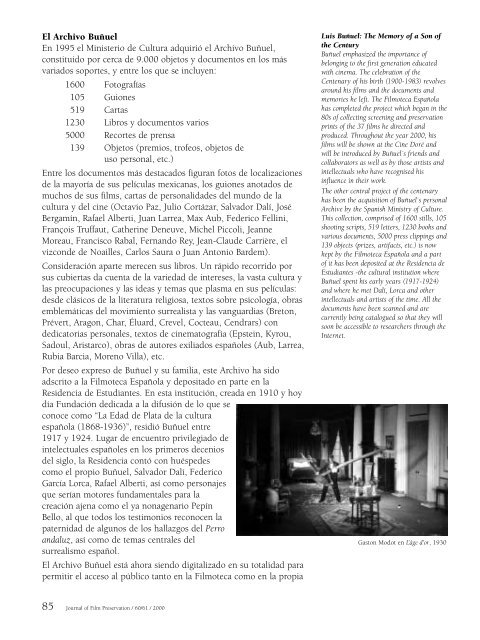Journal of Film Preservation N° 60/61 - FIAF
Journal of Film Preservation N° 60/61 - FIAF
Journal of Film Preservation N° 60/61 - FIAF
You also want an ePaper? Increase the reach of your titles
YUMPU automatically turns print PDFs into web optimized ePapers that Google loves.
El Archivo Buñuel<br />
En 1995 el Ministerio de Cultura adquirió el Archivo Buñuel,<br />
constituido por cerca de 9.000 objetos y documentos en los más<br />
variados soportes, y entre los que se incluyen:<br />
1<strong>60</strong>0 Fotografías<br />
105 Guiones<br />
519 Cartas<br />
1230 Libros y documentos varios<br />
5000 Recortes de prensa<br />
139 Objetos (premios, tr<strong>of</strong>eos, objetos de<br />
uso personal, etc.)<br />
Entre los documentos más destacados figuran fotos de localizaciones<br />
de la mayoría de sus películas mexicanas, los guiones anotados de<br />
muchos de sus films, cartas de personalidades del mundo de la<br />
cultura y del cine (Octavio Paz, Julio Cortázar, Salvador Dalí, José<br />
Bergamín, Rafael Alberti, Juan Larrea, Max Aub, Federico Fellini,<br />
François Truffaut, Catherine Deneuve, Michel Piccoli, Jeanne<br />
Moreau, Francisco Rabal, Fernando Rey, Jean-Claude Carrière, el<br />
vizconde de Noailles, Carlos Saura o Juan Antonio Bardem).<br />
Consideración aparte merecen sus libros. Un rápido recorrido por<br />
sus cubiertas da cuenta de la variedad de intereses, la vasta cultura y<br />
las preocupaciones y las ideas y temas que plasma en sus películas:<br />
desde clásicos de la literatura religiosa, textos sobre psicología, obras<br />
emblemáticas del movimiento surrealista y las vanguardias (Breton,<br />
Prévert, Aragon, Char, Éluard, Crevel, Cocteau, Cendrars) con<br />
dedicatorias personales, textos de cinematografía (Epstein, Kyrou,<br />
Sadoul, Aristarco), obras de autores exiliados españoles (Aub, Larrea,<br />
Rubia Barcia, Moreno Villa), etc.<br />
Por deseo expreso de Buñuel y su familia, este Archivo ha sido<br />
adscrito a la <strong>Film</strong>oteca Española y depositado en parte en la<br />
Residencia de Estudiantes. En esta institución, creada en 1910 y hoy<br />
día Fundación dedicada a la difusión de lo que se<br />
conoce como “La Edad de Plata de la cultura<br />
española (1868-1936)”, residió Buñuel entre<br />
1917 y 1924. Lugar de encuentro privilegiado de<br />
intelectuales españoles en los primeros decenios<br />
del siglo, la Residencia contó con huéspedes<br />
como el propio Buñuel, Salvador Dalí, Federico<br />
García Lorca, Rafael Alberti, así como personajes<br />
que serían motores fundamentales para la<br />
creación ajena como el ya nonagenario Pepín<br />
Bello, al que todos los testimonios reconocen la<br />
paternidad de algunos de los hallazgos del Perro<br />
andaluz, así como de temas centrales del<br />
surrealismo español.<br />
El Archivo Buñuel está ahora siendo digitalizado en su totalidad para<br />
permitir el acceso al público tanto en la <strong>Film</strong>oteca como en la propia<br />
85 <strong>Journal</strong> <strong>of</strong> <strong>Film</strong> <strong>Preservation</strong> / <strong>60</strong>/<strong>61</strong> / 2000<br />
Luis Buñuel: The Memory <strong>of</strong> a Son <strong>of</strong><br />
the Century<br />
Buñuel emphasized the importance <strong>of</strong><br />
belonging to the first generation educated<br />
with cinema. The celebration <strong>of</strong> the<br />
Centenary <strong>of</strong> his birth (1900-1983) revolves<br />
around his films and the documents and<br />
memories he left. The <strong>Film</strong>oteca Española<br />
has completed the project which began in the<br />
80s <strong>of</strong> collecting screening and preservation<br />
prints <strong>of</strong> the 37 films he directed and<br />
produced. Throughout the year 2000, his<br />
films will be shown at the Cine Doré and<br />
will be introduced by Buñuel´s friends and<br />
collaborators as well as by those artists and<br />
intellectuals who have recognised his<br />
influence in their work.<br />
The other central project <strong>of</strong> the centenary<br />
has been the acquisition <strong>of</strong> Buñuel´s personal<br />
Archive by the Spanish Ministry <strong>of</strong> Culture.<br />
This collection, comprised <strong>of</strong> 1<strong>60</strong>0 stills, 105<br />
shooting scripts, 519 letters, 1230 books and<br />
various documents, 5000 press clippings and<br />
139 objects (prizes, artifacts, etc.) is now<br />
kept by the <strong>Film</strong>oteca Española and a part<br />
<strong>of</strong> it has been deposited at the Residencia de<br />
Estudiantes -the cultural institution where<br />
Buñuel spent his early years (1917-1924)<br />
and where he met Dalí, Lorca and other<br />
intellectuals and artists <strong>of</strong> the time. All the<br />
documents have been scanned and are<br />
currently being catalogued so that they will<br />
soon be accessible to researchers through the<br />
Internet.<br />
Gaston Modot en L’âge d’or, 1930
















